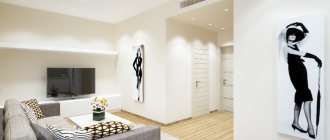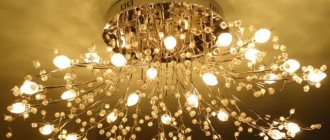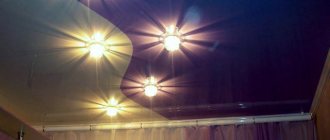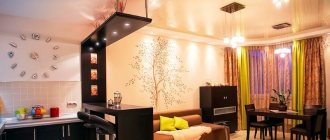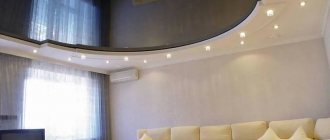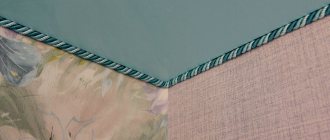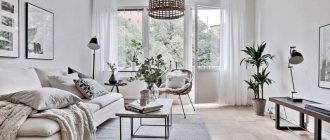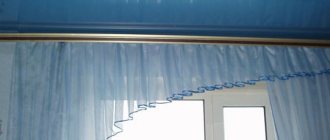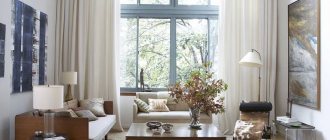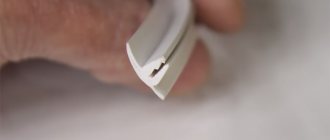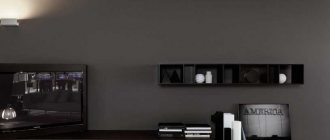Home » Design
DesignCeilings
Alyona
16405 Views
Stretch ceilings are a relatively new thing on the market, but they have already gained great popularity. The proposed arsenal of design tools is wide and varied, and installation of ceilings is surprisingly simple and fast. A small but pleasant problem is perhaps some confusion in front of the rich choice of this type of finishing materials. Everything will be discussed in more detail later in the article.
Types of materials
Stretch ceilings are made from PVC film or polyester fabric. The canvas is stretched onto a frame, which is assembled from special profiles. The installation technology for different materials is similar. The choice depends on the characteristics of the room and taste.
PVC film
Polyvinyl chloride is available in a variety of colors: more than 150 shades. The palette contains:
- classic white for ceilings;
- light pastel colors;
- bright saturated colors;
- and even dark ones (including black).
The texture of the film is also varied. Available in smooth glossy, matte, satin and textured variations.
When choosing a material, not only appearance, but also other features are taken into account. Let's briefly look at the advantages and disadvantages of film. The advantages include:
- Moisture resistance.
- Low cost (compared to fabric ones).
- Easy to clean (suitable for wet cleaning if you choose soft products).
There are also some disadvantages:
- It is more difficult to install (in order for the film to stretch better, it is heated with a heat gun).
- Suitable only for heated rooms, as at negative temperatures it loses elasticity and cracks.
- It breaks easier.
- Less maximum roll width (no more than 3.2 meters).
Textile
The texture of the canvas is related to the production method and the weave of the threads. The surface is matte, not smooth and does not reflect light. Textured ones are also available. The color variety is lower than that of film: only about 20 tones.
Advantages of the fabric:
- Width sufficient for standard sized rooms.
- Durability (harder to damage).
- Resistance to low temperatures.
- Easy to install (no heating required).
The disadvantages of this material are the following:
- The price is higher than that of film ceilings.
- Lower moisture resistance.
- More difficult to care for.
Properly caring for the ceiling
The use of suspended ceilings in the interior is attractive because they do not require close maintenance. Care consists of periodically wiping their surface with a dry and clean cloth. To recreate a shiny surface, you can use polish.
It is preferable to clean matte surfaces with steam or a warm soapy solution using laundry soap.
For fabric ceilings, wet cleaning is used; if there are significant dirty areas, the concentration of the soap solution should not be too high.
To ensure that the ceiling lasts for as long as possible, follow these recommendations:
- during renovations in the apartment, the PVC tension covering must be dismantled, and the fabric-based surface must be covered with a protective film,
- Do not remove dirt from the ceiling surface with a brush.
Textures of paintings
Texture largely determines the overall impression of the ceiling. The choice also affects the price.
Matte
The surface absorbs light and gives the impression of being painted or plastered. It looks laconic, does not draw attention to itself, and in white it resembles an ordinary ceiling. In the film version, this coating is cheaper than others. If the film is soldered, the seam on the matte canvas is almost invisible.
Glossy
The smooth surface reflects light, making the room seem more spacious. The number of lamps is calculated taking this feature into account.
But on such a ceiling dust and stains are more noticeable. Cleaning will have to be done more often. The seam between the individual cuts is also noticeable. Only film has a mirror surface.
Satin
This canvas is semi-matte. In terms of its ability to reflect light, it occupies an intermediate position between the two previous varieties. Also found only in vinyl.
Decorative
Such ceilings are more expensive than those described above. The surface is covered with a pattern or imitates any material:
- metal;
- expensive fabrics (silk, velvet, velor, etc.);
- suede or leather;
- decorative stones (for example, marble of various colors);
- nacre;
- etc.
The manufacturing method depends on the type of ceiling. An unusual textured film is obtained by applying embossing during the production process. For fabric the technology is different. Special paint or even plaster is applied on top.
Combinations of textures
Possible combinations:
- Creation of multi-level structures in which each tier has its own type of fabric. Used in large rooms: halls, living rooms, kitchens, dining rooms, etc.
- Soldering vinyl films on a machine. Suitable for small rooms where it is undesirable to lower the ceiling height. The weld line can be smooth, wavy, zigzag, etc.
The combination of textures creates contrast between the individual parts of the ceiling. This visually increases the space and highlights zones in the room. To enhance the impression, choose different colors.
Often a matte texture is combined with a smooth or decorative one. In the first case, the effect of a difference in height is created (or enhanced). And in the second, the beauty of the texture is emphasized.
Comparative characteristics of ceiling coverings
All ceiling tiles have their advantages and disadvantages. The advantages and disadvantages can be analyzed to select a ceiling covering that will maintain the quality and visual appeal of the interior.
Table. Advantages and disadvantages of modern types of ceilings.
Ceiling type Advantages / Disadvantages
| Stretch ceiling | Luxurious appearance, smooth surface, clean and quick installation, moisture resistance. Ability to handle large amounts of water in case of flooding. | High price, complex installation using specialized equipment, easy mechanical damage. Options with foil are sensitive to temperature changes. |
| Drywall | Possibility of installing multi-level covering. Does not require foundation preparation. Ventilated space under the ceiling. Retains heat, absorbs noise, and is resistant to mechanical damage. | Low resistance to moisture. Framing required. Additional finishing required. Difficult to install and require special skills. |
| Felling trees | Natural and ecological. Creates a cozy atmosphere. Retains heat and absorbs noise. | It is afraid of moisture, loosens when temperature and humidity fluctuate, which leads to the appearance of cracks. |
| Wallpaper | Low price. Can be assembled by yourself. | Seams are coming apart, corners are peeling due to changes in humidity. Short-lived. Foundation preparation required. Burns out. |
| Suspended ceiling | Long service life, easy to maintain, resistant to moisture and high temperatures. | "Eats high." High price. Fragile. |
| Finishing ceiling | Does not require surface preparation and does not significantly reduce height. Allows you to build large volumes. | Difficult to install. |
Choosing a ceiling covering is a responsible decision. Only by carefully thinking through the project and choosing the right material, you will be able to use all the advantages and compensate for the shortcomings of the room, creating a unique and stylish design.
Variety of colors and their combinations
This is another important factor when choosing a stretch ceiling. It is worth considering the size and purpose of the room.
Pastel
Light colors visually increase the space, so they are suitable for rooms with low ceilings. This effect is especially pronounced for the cold spectrum - for example, blue or gray.
Pastel shades easily fit into the interior without attracting undue attention. Dark or bright colors of furniture, curtains and other objects look good against their background. More often they choose beige, blue, delicate pink, light green or pale yellow tones.
Bright
The richly colored ceiling attracts the eye and becomes the visual center of the room. But in this case, it is better to choose calmer tones for the floor, walls and large interior objects. The room looks more harmonious if the shade of the canvas is repeated in detail.
Bright ceilings create an active environment. They look better in glossy format, which gives the surface a sense of depth. Choose purple, burgundy, blue, green, yellow, brown and other options.
When choosing a color, take into account the lighting of the room. Warm colors, especially yellow, are chosen for rooms whose windows face north. This creates the impression of sunlight and warmth. And in good lighting, blue and other cool shades are suitable.
Contrasting
Possible combinations:
- different ceiling levels (usually two), for each of which a specific color is selected;
- connection of canvases at the same level;
- contrasting patterns (rare).
The first two options divide the space into zones and visually add height to the room. Canvases of different colors are connected in a straight line, broken (zigzag) or smoothly in the form of a semicircle or wave. Peculiarities of perception also depend on the choice of specific colors, so we will consider common options.
Black, especially in lacquer, looks unusual and attractive. But in itself it makes the room too dark and gloomy. Black is “diluted” with other colors. The classic option is a combination with white. This contrast is the strongest possible. The room looks interesting and at the same time quite strict. The decor uses white, pastel or bright objects. Dark tones should not be added in large quantities.
A close option is brown and white. It looks softer and more unusual. The yellow-brown ceiling is a softened, less contrasting option. The room creates a cozy mood. These colors are suitable for all ethnic styles.
The white and blue canvas evokes associations with the sky or sea. It has a calming and calming effect. Looks interesting with spotlights reminiscent of stars.
Red and white are an active combination. The overall tone is warm, so in rooms with windows facing south and southwest you should choose more carefully.
Multicolored
In addition to the variations listed above, many others are possible. It is advisable that the shades you choose be present in the rest of the interior. Then the situation will look harmonious.
Not only contrasting colors, but also colors that are similar in warmth and light look good together. For example, white with any pastel looks very gentle. The combination of several bright colors at once creates a festive mood. It’s better to avoid a combination of dark tones; they make the room look lower.
Types of ceiling structures
Divided by the number of levels.
Two-level
They look aesthetically attractive, stylish and modern, have original configurations and do not visually overload the room.
Multi-level
Sophisticated designs allow you to create one or more unusual shapes, which can be located at different levels.
Ceiling design options
There may be differences not only in color, but also in shape. This gives the surface more expressiveness. But it is necessary to take into account the size of the room.
Single-level
The simplest design option. The canvas is stretched at an equal height. The ceiling level is reduced minimally. 3-5 cm from the rough ceiling is enough, and if recessed lamps are selected - 10-15.
Suitable for low rooms. Installation is quite fast - 2-3 hours in a room of about 20 m². Due to ease of installation, it is cheaper than other varieties.
Two-level
Part of the ceiling drops lower. This way you can hide communications or simply divide the space into separate zones. Sometimes the lower tier is built from plasterboard, in other cases both parts of the ceiling are made of tension.
Depending on the relative position, the following options are possible:
- the lower level is located along the perimeter of the ceiling in the form of a frame;
- similar to the previous one, but the upper tier has the shape of an oval or circle;
- part (half, third, etc.) is omitted along the entire width;
- the lower tier is in the center and is made in the shape of any figure;
- several similar designs, etc.
As a rule, fabrics of different texture or color are selected for levels. Often additional lighting is built into the lower tier. The ceiling level decreases more, so the initial height of the room should be at least 2.75 meters.
For installation, a complex structure of profiles is assembled. It is necessary not only to stretch the canvases at different heights, but also to ensure a beautiful transition between them. Only professionals can handle this task. The cost also increases.
Multi-level
The design of suspended ceilings can be more complex with three or more tiers. Any variations described in the previous section and their combinations are possible.
But each level “takes away” part of the height, and the whole structure as a whole seems rather cumbersome. Therefore, such ceilings are not installed in ordinary apartments. They are suitable for large spaces - commercial premises or combined areas of cottages.
Hidden backlight
It is not necessary to make diodes a noticeable element of a stretch ceiling: they can be practically invisible, but still look very atmospheric.
Here the field for experimentation is practically unlimited, but it is better to abandon fabric stretch ceilings - they are much denser, so the effect will not be too noticeable. Thin PVC film is ideal for installing hidden lighting: it hides the lighting structure, but does not interfere with the passage of light.
Try laying LED strips in a figurative manner: for example, in the form of a flower or just a beautiful pattern. This way you will get an unusual decor, which will also serve as a source of light.
Another interesting technique is the use of translucent stretch fabric. In this case, the structure will seem to glow on its own.
By the way, this method is also suitable for small rooms: despite the fact that installing such a ceiling will take up some of the height of the walls, the room will seem much larger.
The use of hidden lighting for combined ceilings may also be interesting. This way you will emphasize the difference in texture of drywall and tension fabric.
We hope we were able to comprehensively answer the question of what suspended ceilings are. True, now there is a risk of another problem arising - they are so diverse that it is difficult to make a choice. However, who is stopping you from combining several design techniques in one room? Good luck with your experiments!
Lighting as a design element
Stretch ceilings allow you to use lamps of various types - both individually and together. The surface can be made even more unusual and expressive.
The location of all lighting fixtures is thought out before installing the ceiling. They are attached not to the tension fabric, but to the rough ceiling. Therefore, you need to pre-mount the mortgages to which the lamps will be screwed. Electricity is also provided before installation.
Important! The stretch fabric does not tolerate strong heat. The power of lighting devices should not be higher than 40-50 W. And when embedded in a film surface, be sure to protect it with thermal rings.
Chandelier
A chandelier is an attribute of traditional style, suitable for classic interiors. More original models also look good in modern apartment designs.
Typically hung in the center of a room or area. The light from the chandelier is beautifully reflected and refracted on the glossy ceiling. On satin and some textured canvases (for example, metallic, mother-of-pearl) the effect is less pronounced, but it also looks interesting.
Spots
Spotlights create soft and diffused lighting. The light bulbs are located:
- evenly over the entire plane;
- lines along the boundaries of the zones;
- in the form of patterns (zigzags, waves, figures, etc.);
- and in any other combinations.
Advice! It is advisable to divide the spots into groups. Then you can turn them on both together and separately, thus adjusting the light intensity.
It is necessary to accurately calculate the number and location of devices so that the room or individual parts are not too dark. For matte canvases you will need more of them than for glossy ones.
LED lights
Typically installed around the perimeter of the room or behind the edge of the lower tier in a multi-level structure. In the latter case, the ceiling appears higher.
Glowing ceilings and light lines
For this effect, the tape is mounted under the canvas. The lighting is soft and diffused. Sometimes they take a special translucent film, then it is brighter. Lines can be used to “draw” patterns on a plane.
Combined lighting
The listed types of light sources are combined with each other. Especially in large rooms where one device is not enough. When combined, it becomes possible to choose different light scenarios, from bright daytime to romantic evening.
The classic proposal of designers: install a chandelier in the center of the room, and install spots for additional lighting in separate areas (for example, the work area). And lay an LED strip around the perimeter of the room. It will also highlight the boundaries of the levels.
Selecting lighting
Thoughtful lighting is important when creating the perfect design. Spotlights placed around the entire perimeter will help make a room with a suspended ceiling look elegant and add an element of solemnity. Chandelier shades should be directed downward, otherwise there is a risk of damaging the ceiling surface due to temperature exposure.
Using ceiling lighting you can achieve the effect of zoning a room. Built-in lamps will help visually increase the height of the walls.
Additional advantages of suspended ceilings include the ability to choose not only overhead, but also recessed lamps, as well as a large number of different LED strips and spotlights of various diameters.
Additional decor
When installing a stretch ceiling, a small gap remains between the canvas and the walls. This is due to the fact that the profile into which the PVC film or fabric is inserted has a certain thickness. After installation, the gap is covered with a ceiling plinth, masking tape or decorative cord. With each option the room looks a little different. They have their pros, cons and choices.
Colored masking tape
The insert is made of polyvinyl chloride - the same material as the film sheet. The tape is carefully tucked into the gap between the ceiling and the wall or into the separating baguette that connects the canvases. Depending on the location and size of the gap, choose one of several types of tapes.
The color range is wide, you can choose a shade that matches the film. This way the tape will merge with the ceiling and will not be noticeable. Sometimes they choose a finish that matches the color of the walls or contrasts with both surfaces. The last option emphasizes the line, so it is only suitable if the planes are well aligned.
Masking tape is an inexpensive and versatile way to decorate. It is easy to install, and if necessary, it can be removed and replaced with another one or returned to its place (for example, when temporarily dismantling the ceiling). The insert fits over small irregularities. But if the walls are noticeably crooked, the tape will not be able to hide the defects.
Ceiling plinth
This is a classic finish and the surface looks more traditional. Nothing should be attached to the canvas, as it will sag and may even be damaged. The plinth is attached only to the wall, which affects the choice of products.
It is preferable to choose lighter options: PVC, polyurethane or foam. The shape is better suited to moldings whose vertical part is wider than the horizontal. So there is more space for mounting.
Skirting boards are glued to the wall or screwed with self-tapping screws. The fastener caps on top are masked with putty. Therefore, it is quite difficult to change such decor. It will not be possible to reinstall a dismantled piece of plinth.
The appearance of the moldings is quite varied. There are different colors, imitation of other materials, stucco, wooden patterns, metal, etc. When choosing a specific model, you should take into account the style of the room, as well as the pretentiousness of the decor. When there are already a lot of details and decorations, it is better to take a simple molding. And if the room is furnished succinctly, the baseboard can be more complex, with patterns. Decorative lighting is sometimes installed behind the molding. This will make the ceiling appear higher.
The cost of skirting boards varies greatly. The price depends on the material and complexity of the specific model. But in general, such finishing is more expensive than a camouflage insert.
Decorative cord
This option has been used relatively recently. It makes the room look unusual and elegant. A textile cord of selected thickness is inserted into the slot. The same cord can be used in tying curtains or decorating furniture.
The edging comes in different colors, single or multi-colored. Sometimes lurex (golden and silver threads) is added. As with PVC inserts, the color is selected to match the ceiling, walls or contrast. But the overall effect is different. The room looks more comfortable. Decorative cord looks better with fabric ceilings, but it is often used with film.
This insert is soft, so it hides unevenness to some extent. But the strong curvature of the walls will be noticeable. Installation is simple; the cord can be pulled out if necessary. The disadvantages are that textiles collect dust. But it can be cleaned with a vacuum cleaner or washed.
Arrangement of figures on the ceiling
The balance and appearance of the entire space will depend on the specific location.
In the center
A figure placed in the center, for example around a chandelier, gives the room neatness and does not disturb the harmony.
In the corner
Corner figured models allow you to diversify the ceiling design and give it special attractiveness and uniqueness.
Over the entire surface
Curvilinear elements across the entire surface can delimit or emphasize space and direct attention to certain parts of it. For such structures, you need to take into account the overall dimensions of the room so that the ceiling plane does not look too massive.
The photo shows a combined figured ceiling located over the entire surface.
Stretch ceilings in different interior styles
High tech
This style is characterized by rectilinear forms, an abundance of technology and metal. An excellent solution would be glossy white ceilings or bright, preferably cool, tones. The canvas with a metallic effect of any shade looks good.
There can be one or more tiers. Simple and clear geometric shapes are desirable. For lighting, a system of built-in lamps is chosen, often in combination with a hidden LED strip.
Classic
This direction is distinguished by traditionalism, simplicity and lack of pretentiousness. Matte canvases are chosen for the ceiling. Fabric ones look especially good, but film ones are also suitable. As an additional decor, a plinth is installed, simple or with laconic patterns.
The most commonly chosen color is white. But a combination with other light shades, such as beige or gray, is also suitable.
In a classic interior, a central chandelier is used for lighting. If necessary, it is supplemented with spots of a laconic design or built-in lighting.
Minimalism
Ceilings in pastel colors, especially satin, are suitable for this style. Rich decor, additional levels, etc. are inappropriate; the surface should be simple and without frills. A combination of devices made in a simple style is used for lighting. The joints are masked with vinyl tape.
Fusion
The trend is characterized by original colors and bold combinations. The same applies to ceilings. Smooth, soft lines and different tiers are preferred.
Bright shades and imitations of unusual materials - leather, stone, etc. fit well. Ceilings with perforations are suitable. But it is important to maintain harmony with the rest of the room.
Provence
The style of one of the French provinces is characterized by pastel colors and smooth lines. For ceilings, choose matte or satin fabrics. Complex structures are often built: a second level with rounded corners, domes and arches.
As an additional decoration, a cord or ceiling plinth is attached. Moldings that imitate carved wooden panels look interesting.
Loft
Premises in this style look like industrial facilities. There is exposed brickwork, bare concrete, and various pipes. A correctly selected ceiling emphasizes these features.
Only matte canvases are used. White and gray colors are suitable. The ceiling is placed in one or two levels, depending on the size. In large studios, height differences help separate zones.
What should you abstain from?
Not all trends have survived; many are now considered a sign of bad taste. One of them was gloss. Its main advantage was the visual increase in space.
Worth paying attention! Experts say gloss isn't expected to make a comeback in trends anytime soon.
However, its serious drawback was its cheap appearance. The addition of a glossy ceiling to the interior did not look too expensive. It looked great only in simple interiors with a lot of expensive decorative elements.
And even plasterboard ceilings should be avoided, but only those that have a complex design. Some of their options are acceptable for installation today, but in most cases they do not look very attractive.
Scandinavian and minimalist interior design are at the forefront, and such decor has no place in homes decorated in the above styles. The only exception is when the ceiling has different levels due to technical requirements.
Ideas for rooms
When developing a design, it is worth considering not only the style, but also the overall purpose of the room.
Living room
Both traditional white ceilings and bright ones are installed here. The gloss looks good. If size allows, it is better to make two levels for the hall. A chandelier and local sources are used as lighting.
Bedroom
It is important to create an atmosphere of comfort and tranquility. Matte or satin texture and pastel colors will help with this. You shouldn’t get carried away with elaborate decoration and complex designs. A central chandelier is not necessary; built-in lamps are sufficient.
%
Kitchen
The coating must first of all be practical, especially in the food preparation area. Smooth ceilings are preferable - particles of dirt, grease and soot (which arise from a gas stove) are more likely to settle on matte and textured ones. A beige ceiling would be a good solution - such marks are less noticeable on it.
In a large room, you can highlight the dining area by creating a separate level for it. And additional lighting will be useful near the stove and sink.
Bathroom
In rooms with high humidity, film ceilings are installed. White and blue colors are often used in the bathroom. It is better to stretch the canvas at the same level so as not to overload the space.
Corridor
Common problems in hallways are lack of lighting and space. They are solved by installing a sufficient number of light bulbs and choosing light colors. In most cases, a smooth ceiling that expands the space looks good. It also increases the level of illumination. But if the corridor is narrow and high, gloss should be used with caution so that the walls do not appear even closer to each other.
Balcony
For unheated rooms, only fabric is suitable, since the film will collapse in the cold. It is better to choose a simple one-tier design. Of the colors, all light shades are suitable (taking into account the rest of the interior).
Children's room
Pastel colors will suit the child. You can use bright colors, but with caution - in large quantities or in contrasting combinations, they will not allow you to fall asleep peacefully.
Children love the pictures on the ceiling. To do this, choose a favorite character, a cute animal, flowers or a view of space, depending on the tastes of the owner of the room.
Options for geometric shapes
The most popular and sought-after types of figures that are used in design.
Circles and ovals
They are distinguished by simple execution, harmonious and complete appearance. Circles, ovals or double circles can soften the angularity of the interior and create a relaxed atmosphere in it.
The photo shows a white figured ceiling in the shape of a circle in the kitchen interior.
Squares and rectangles
They are the most classic and convenient solution. White, beige or black squares and rectangles give the space calm, balance and stability. In addition, such designs will help to visually expand a narrow room.
Polygons
Various polygonal shapes, such as hexagons, give the ceiling space a special dynamic and fill the room with modern notes.
The photo shows a living room and a figured suspended ceiling in the shape of hexagons.
Semicircle
The unusual and creative crescent shape will undoubtedly become the brightest accent of the entire room.
Modern trends in the design of suspended ceilings
Various effects that expand the space or hide the real shape of the room are becoming fashionable. They are used separately or together.
Photo printing
You can transfer any image to the ceiling: landscapes, the sky with clouds or stars, butterflies, animals, flowers, etc. Drawings with a 3-D effect, which occurs due to high quality and the use of chiaroscuro, look interesting.
Recently, double vision technology, or hidden photo printing, has appeared. The image is applied to the reverse side of the canvas. It only becomes visible when the hidden backlight is turned on. The front surface can be clean or with a different pattern. In the latter case, the images are superimposed.
Gapless ceilings
This technology uses special baguettes. The canvas is attached in such a way that there is no gap left near the wall. But a gapless connection is only suitable for perfectly smooth walls, otherwise gaps will be visible.
floating ceiling
To achieve this effect, a second tier or plinth is installed along the perimeter of the walls. An LED strip is placed in the resulting space. When turned on, it seems that there is free space between the ceiling and walls.
Artistic perforation
The structure consists of two layers. The top one is a regular ceiling. And on the bottom there are holes of different shapes and sizes. They can form a pattern on the entire ceiling or an image in the center, along the perimeter or in one of the corners. This perforation goes well with hidden lighting.
Starry sky
An image of space is applied to the canvas. LEDs simulating stars are connected to individual points. It can be combined with double vision technology, when a second pattern is printed on the back of the canvas, which becomes visible only when the backlight is turned on.
Stretch ceilings of non-standard shape
The film canvas takes on an unusual and stylish look if you create a wave, arch, dome, cone or bell. The figures are mounted one at a time or in groups. They look more interesting in gloss. But you need to remember that this design reduces the ceiling level.
When choosing the type and color of the canvas, take into account the size and purpose of the room, the general style and personal preferences. Beautiful stretch ceilings can be created in any room of the house - both in a luxurious hall and in a modest kitchen.
Starry sky
Combining fiber optic cable, LEDs and spotlights allows you to create an amazing effect - simulating a real starry sky in almost any room.
Just imagine: the mysterious twinkling of stars, three-dimensional planets (of course, not real ones, but made using 3D printing), comets... and all this in your bedroom or living room!
This option is considered almost universal. In addition, the controller will allow you to adjust the brightness of the glow and adjust the type of glow: we recommend using this particular option for the star ceiling.
By the way, it is not at all necessary to choose a dark background: you can easily install such lighting on any canvas. Recently, the combination of a printed ceiling with clouds has become popular, which turns into the night sky when it gets dark.
Chandeliers in the shape of comets or spaceships will help complement such an interior.
An interesting technique: Who said that you need to limit yourself to decorating only the ceiling? Try lowering part of the illuminated canvas onto the wall. It will not only look unusual: the room will seem much larger due to the light reflections.
Read more about ceilings in the “starry sky” style here.
Ceiling with matte finish
The matte ceiling is suitable for decorating any interior. Outwardly, it looks impeccably smooth. There is absolutely no glare on the surface.
Peculiarities:
- classic style
- occupy 3-4 cm of space
- nothing is reflected on the surface
- huge color palette
- durability
Photo printing
An excellent solution would be to add a picture to the canvas. Photo printing is in demand today; it allows you to add a design to the ceiling. A picture up to 5 meters in size is applied to the surface of the canvas using a printer. Look at the designer stretch ceilings in the photo. They contain extraordinary solutions.
The image is selected in accordance with the purpose of the room.
For the bedroom, a great choice would be the starry sky, clouds, flowers. Pictures are applied using the following types of printing.
- Eco-solvent is used to obtain 3D images.
- Latex printing is suitable for large products.
- The ultraviolet type looks great even against a dark background.
Stretch ceilings in the interior amaze with their variety and depth. They will fill it with new colors and mood.
See alsoHow to use chandeliers in the interior
